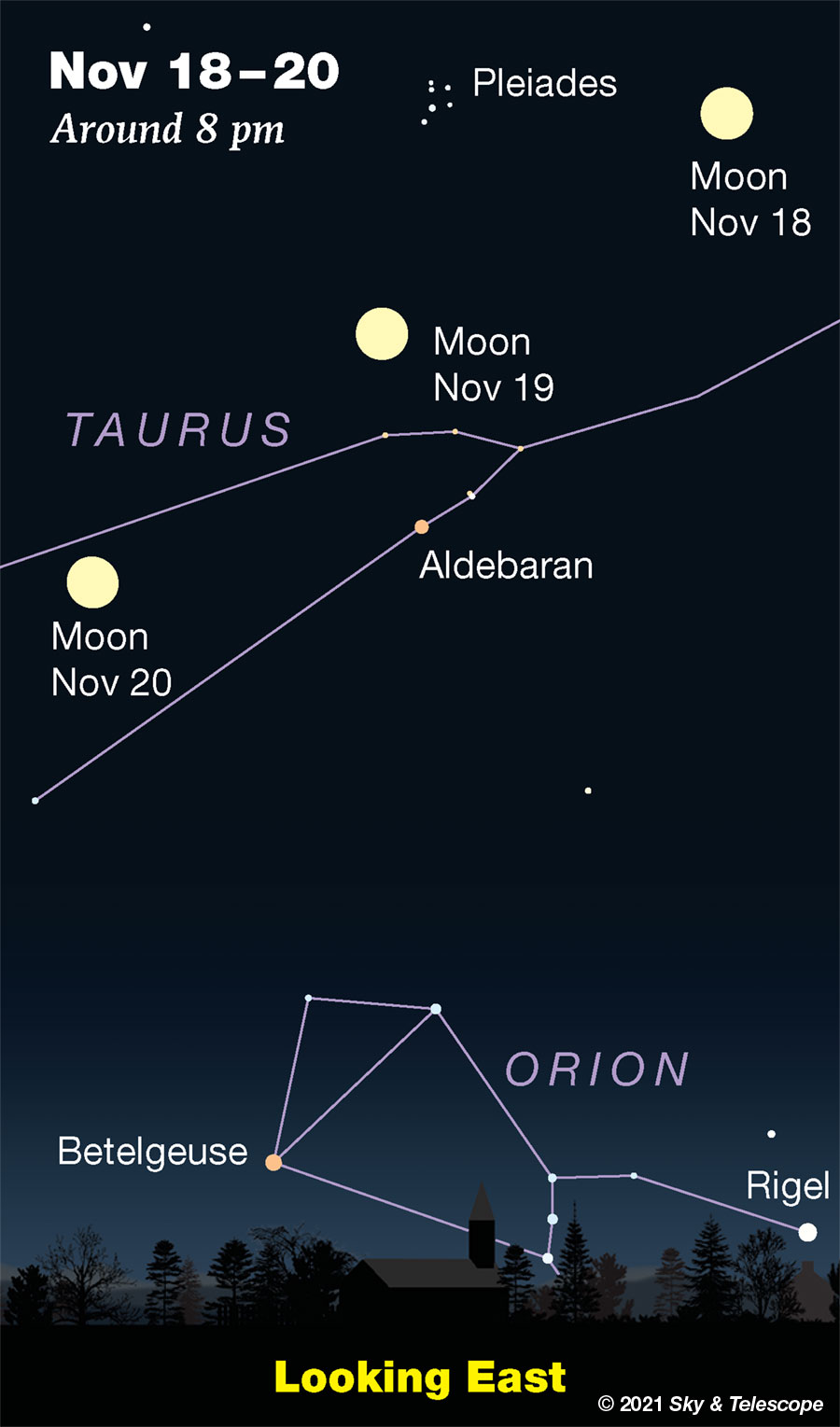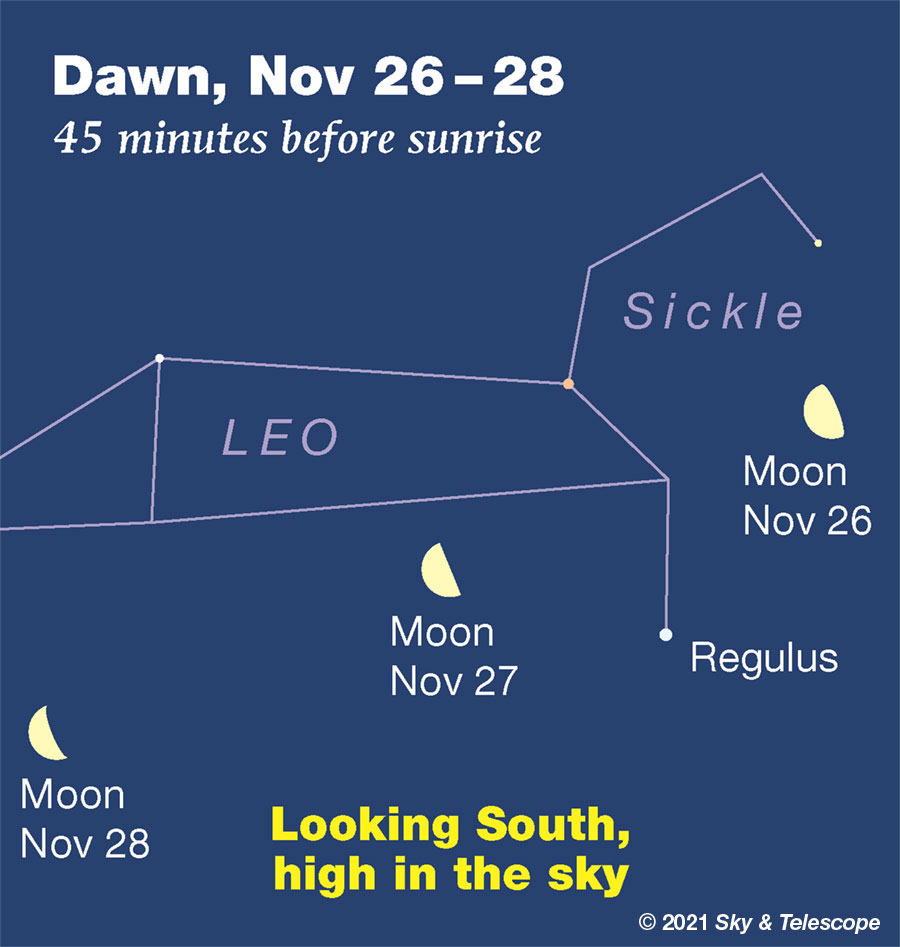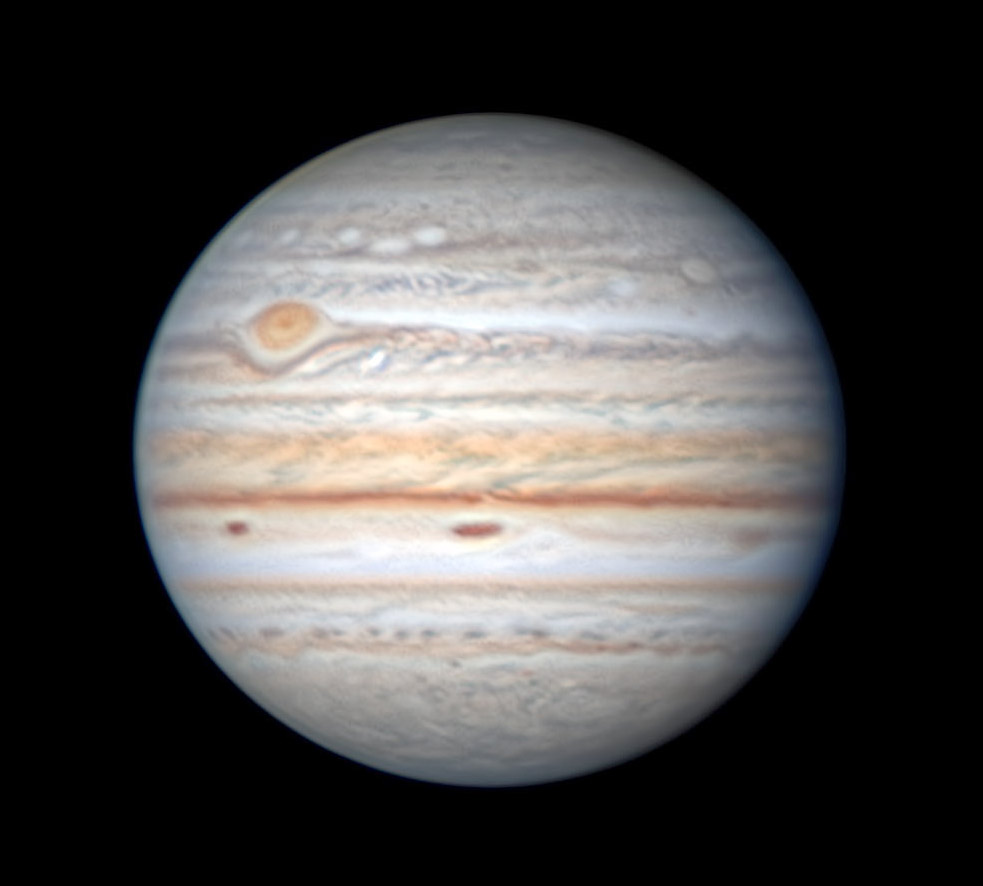FRIDAY, NOVEMBER 19
■ Venus and Nunki. As twilight deepens toward dark this evening, spot dazzling Venus low in the southwest. Just 0.2° to its left, if you're viewing from North America, is the brightest star of the Sagittarius Teapot handle: 2nd-magnitude Nunki (Sigma Sagittarii). Bring binoculars; Nunki is only 1/500 as bright as Venus. Nunki, 225 light-years away, is 30 million times farther than Venus at 4 light-minutes.
Binoculars may also show the other three stars of the Teapot handle in the same field of view. They're 89, 120, and 230 light-years away, roughly typical for run-of-the-mill naked-eye stars.
■ The Moon, just past full, shines in early evening almost exactly halfway between the Pleiades above it and Aldebaran below it, depending on your location. The Moon is precisely in line between them around the end of twilight for much of North America's East Coast. Holding up a ruler or a pencil to the sky, how accurately can you time the Moon's passage across this line? To mark the center of the Pleiades, pick Alcyone, the cluster's brightest star.
Watch the Moon move farther east of this line hour by hour through the night, as it creeps eternally eastward in its orbit around Earth.

SATURDAY, NOVEMBER 20
■ Venus and Jupiter, the two brightest celestial objects after the Sun and Moon, continue to blaze this week during and after twilight. Venus is low in the southwest; Jupiter is high in the south. Saturn glows dimmer less than halfway from Jupiter to Venus.
Watch this line of three planets shorten for the next three weeks.
■ We're two thirds of the way through fall, so Capella is shining in the northeast as soon as the stars come out. As night grows darker, look to its right by about three fists at arm's length for the frosty little Pleiades cluster, the size of your fingertip at arm's length.
SUNDAY, NOVEMBER 21
■ By about 8 p.m. Orion is clearing the eastern horizon as shown above, depending on how far east or west you live in your time zone.
Orion's tilt while rising depends on your latitude. If you live north of 33° N (Los Angeles, Atlanta, the Nile delta, Shanghai), Betelgeuse will be higher than Rigel. That's the case in the illustration above, drawn for 40° N. If you're south of 33°, Rigel will be higher right after they rise; Orion comes up foot first.
As the night goes on, however, Betelgeuse always gain the upper position — as seen from anywhere in the Northern Hemisphere.
■ Down below Orion, Sirius rises around 10 p.m. No matter where they are in the sky, Sirius always trots along two hours behind Orion. Or equivalently, one month behind Orion.
MONDAY, NOVEMBER 22
■ The bowl of the Little Dipper is swinging down after dark at this time of year, lower left of Polaris due north. The Little Dipper's lip is Kochab, equal to Polaris in brightness; the rest of it is dim. By about 11 p.m. it hangs straight down from Polaris.
TUESDAY, NOVEMBER 23
■ The waning Moon rises in the east-northeast around 8 tonight. Once it gains a bit of altitude, spot Pollux upper left of it by only 3°. Castor is 4½° above or upper left of Pollux.
The Moon, Pollux, and Castor line up in a straight line after midnight in the Eastern time zone; in late evening for the West Coast.
■ Around 7 or 8 p.m., depending on where you live, wintry, zero-magnitude Capella rises exactly as high in the northeast as zero-magnitude Vega, the Summer Star, has sunk in the west-northwest. Yes, the season tips to cold.
WEDNESDAY, NOVEMBER 24
■ In early evening Altair shines in the southwest about halfway up the sky, three or four fists left of brighter Vega. Altair is the only bright star in that area. It's the eye of Aquila, the Eagle.
Just upper right of Altair, by a finger's width at arm's length, is 3rd-magnitude Tarazed. Down from there runs Aquila's dim backbone, along the Milky Way in the moonless dark of early evening tonight.
This arrangement reminds me of another Summer Triangle bird, Cygnus the Swan, whose long neck and backbone also run along the Milky Way. Cygnus currently flies high to Aquila's upper right.
■ With the Moon gone from the early evening sky, set up your scope to explore the horizontal "Water Carrier Line Dance" of telescopic targets crossing the Water Jar of Aquarius, now at its highest in the south — using Ken Hewitt-White's "Suburban Stargazer" article and charts in the November Sky & Telescope starting on page 54.
THURSDAY, NOVEMBER 25
■ Does the Sun already seem to be setting about as early as it ever will? You're right! We're still almost a month from the winter solstice — but the Sun sets its earliest each year around December 7th, if you're near latitude 40° north. And already the Sun sets within only about 3 minutes of that time.
A surprising result of this: The Sun actually sets a trace earlier on Thanksgiving than on Christmas — even though Christmas is around solstice time!
But in celestial mechanics, every seeming abnormality is balanced out by an equal abnormality somewhere else. This offset of the earliest sunset from the solstice date is balanced out by the opposite happening at sunrise: The Sun doesn't come up its latest until January 4th. Blame the tilt of Earth's axis and the eccentricity of Earth's orbit.
■ As dawn begins on Friday morning the 26th, the waning Moon shines at the Sickle of Leo, as shown below.

FRIDAY, NOVEMBER 26
■ The last-quarter Moon rises in Leo around 11 p.m. tonight. By dawn on Saturday the 27th it's high in the south below Leo's belly, as shown above. The Moon is exactly last-quarter at 7:28 a.m. Saturday morning EST.
SATURDAY, NOVEMBER 27
■ Around 7 or 8 p.m. this week, the Great Square of Pegasus rests in its level position very high toward the south. (It's straight overhead if you're as far south as Miami.) Its western (right) side points very far down toward Fomalhaut. Its eastern side points down toward Beta Ceti, also known as Deneb Kaitos or Diphda, less far down and less directly.
Now descending farther: If you have a very good view down to a dark south horizon — and if you're not much farther north than roughly New York, Denver, or Madrid — picture an equilateral triangle with Fomalhaut and Beta Ceti as its top two corners. Near where the third corner would be (just a bit right of that point) is Alpha Phoenicis, or Ankaa, in the constellation Phoenix. It's magnitude 2.4, not very bright but the brightest thing in its area. It has a yellow-orange tint (binoculars help check). Have you ever seen anything of the constellation Phoenix before?
This Week's Planet Roundup
Mercury is hidden deep in the glow of sunrise.
Venus, a dazzling magnitude –4.8, shines in the southwest during and after twilight. Venus has almost reached its greatest height and greatest brilliancy for this apparition. This week it's on or above the vastly fainter handle of the Sagittarius Teapot.
Mars, far and faint at magnitude +1.6, is emerging low in the sunrise. Try for it with binoculars just above the east-southeast horizon about 45 minutes before sunup. You're catching Mars at the very start of its new apparition, which will run for almost two years. (Mars's opposition, the near-midpoint of the apparition, will come on the night of December 7, 2022 — when, by coincidence, the Moon, necessarily full, will occult it for much of North America!).

The South Equatorial Belt, which seems to float the Great Red Spot, is mostly pale. The North Equatorial Belt is dark red along its south edge and sports two dark red barges.
Jupiter and Saturn, both in Capricornus, shine in the south to southwest during evening far to the upper left of Venus. Jupiter is the bright one at magnitude –2.4; Saturn, 16° to Jupiter's lower right, is mag +0.7, hardly more than 1/20 as bright.
Look 22° (two fists at arm's length) lower left of Jupiter for Fomalhaut, the Autumn Star, magnitude +1.2.
Saturn sets around 9 p.m. Jupiter follows it down about an hour later.
Uranus (magnitude 5.7, in southern Aries above the head of Cetus) is well up in the east after dark. See Bob King's Uranus Queues Up for Opposition, with finder chart.
Neptune (magnitude 7.9, at the Aquarius-Pisces border) is already high in the southeast at nightfall.
All descriptions that relate to your horizon — including the words up, down, right, and left — are written for the world's mid-northern latitudes. Descriptions and graphics that also depend on longitude (mainly Moon positions) are for North America.
Eastern Standard Time, EST, is Universal Time (also called UT, UTC, GMT, or Z time) minus 5 hours.
Want to become a better astronomer? Learn your way around the constellations. They're the key to locating everything fainter and deeper to hunt with binoculars or a telescope.
This is an outdoor nature hobby. For an easy-to-use constellation guide covering the whole evening sky, use the big monthly map in the center of each issue of Sky & Telescope, the magazine of the American Astronomical Society.
Once you get a telescope, to put it to good use you'll need a detailed, large-scale sky atlas (set of charts). The basic standard is the Pocket Sky Atlas (in either the original or Jumbo Edition), which shows stars to magnitude 7.6.

Next up is the larger and deeper Sky Atlas 2000.0, plotting stars to magnitude 8.5; nearly three times as many. The next up, once you know your way around, are the even larger Interstellarum atlas (stars to magnitude 9.5) or Uranometria 2000.0 (stars to magnitude 9.75). And be sure to read How to Use a Star Chart with a Telescope.
You'll also want a good deep-sky guidebook, such as the big Night Sky Observer's Guide set by Kepple and Sanner.
Can a computerized telescope replace charts? Not for beginners, I don't think, and not on mounts and tripods that are less than top-quality mechanically, meaning heavy and expensive. And as Terence Dickinson and Alan Dyer say in their Backyard Astronomer's Guide, "A full appreciation of the universe cannot come without developing the skills to find things in the sky and understanding how the sky works. This knowledge comes only by spending time under the stars with star maps in hand."
![]() Audio sky tour. Out under the evening sky with your
Audio sky tour. Out under the evening sky with your
earbuds in place, listen to Kelly Beatty's monthly
podcast tour of the heavens above. It's free.
"The dangers of not thinking clearly are much greater now than ever before. It's not that there's something new in our way of thinking, it's that credulous and confused thinking can be much more lethal in ways it was never before."
— Carl Sagan, 1996
"Facts are stubborn things."
— John Adams, 1770
 4
4









Comments
Rod
November 19, 2021 at 6:26 am
Early this morning near 0230 I was out viewing the partial lunar eclipse. I placed a stargazing report at Bob King's report page. https://skyandtelescope.org/astronomy-blogs/explore-night-bob-king/a-near-miss-total-lunar-eclipse/#comment-378351
I was a lovely sight in 10x50 binoculars and telescope views.
You must be logged in to post a comment.
TenOfSwords
November 19, 2021 at 1:29 pm
I sincerely doubt that Mars will be realistically visible to anyone who does not own a telescope the size of a bazooka until the week between Christmas Day and New Year's Day.
The Old Farmer's Almanac has this to say about the subject: "It (Mars) might be glimpsed, low and dim at magnitude 2, as a predawn morning star in Scorpio during the final few weeks of the year" (Mars will pass 6.5 degrees north of Antares on December 26; I always look for the "heliacal rising" of Antares, and it typically happens right around the winter solstice).
You must be logged in to post a comment.
Anthony Barreiro
November 19, 2021 at 5:16 pm
I observed Mars through 10x42 binoculars (more of a pop gun than a bazooka) the morning of 11 November in San Francisco. Mars was easy to find that morning, conjunct with brighter Mercury. Since then the weather has been uncooperative.
You must be logged in to post a comment.
Rod
November 19, 2021 at 9:10 pm
Today has been a great viewing day, starting with the lunar eclipse I posted earlier about seeing this morning. Tonight I enjoyed views of Venus at 200x and tracked down Ceres in Taurus, just less than 5-degrees from the waning gibbous Moon. That took some doing and I viewed at 31x. I used Stellarium 0.21.2 and Starry Night Pro Plus 8 to check the position in the sky. Here are some notes from this evening session. [Observed 1700-1730 EST/2200-2230 UT. Sunset 1650 EST/2150 UT. Venus set 1936 EST/0036 UT, 20-Nov. I enjoyed viewing Venus tonight shortly after sunset using 9-mm eyepiece with 1.8x Barlow lens. 200x views using #12 Yellow filter. Venus phase changes very distinct. Venus near 33 arcsecond angular size, disk illumination 36.9% according to Stellarium 0.21.2. The telescope true FOV at 200x close to 25 arcminutes. Temperature 5C, winds north at 11 knots so at times, Venus bounced a bit at 200x because of vibration in the telescope tube from the winds. Venus moved quickly across the FOV at 200x.]
Later near 1930 EST, I tracked down Ceres and this was great fun. [Observed 1930-2030 EST/0030-0130 UT 20-Nov. Waning gibbous moon rise 1704 EST/2204 UT in Taurus. The waning gibbous Moon less than 5-degrees angular separation from Ceres tonight in Taurus. I was able to locate Ceres and view using 32-mm plossl eyepiece at 31x. True FOV 96 arcminutes. Ceres position near mid-point or mid-way between Delta1 Tauri and Gamma Tauri stars. These two stars just a bit more than 2-degrees angular separation. Starry Night Pro Plus 8 showed accurate position in the sky. Ceres near 3 stars, easily showing the asteroid location tonight. HIP20441, 63 Tauri, and TYC1264-778-1. Apparent magnitudes for these three range from +5.62 to +8.12. Delta1 and Delta2 Tauri stars visible in the FOV too. Very clear skies with temperature 3C and N winds 7 knots. Some owls were raising a fuss in the woods when I was out tonight.]
You must be logged in to post a comment.
You must be logged in to post a comment.